-
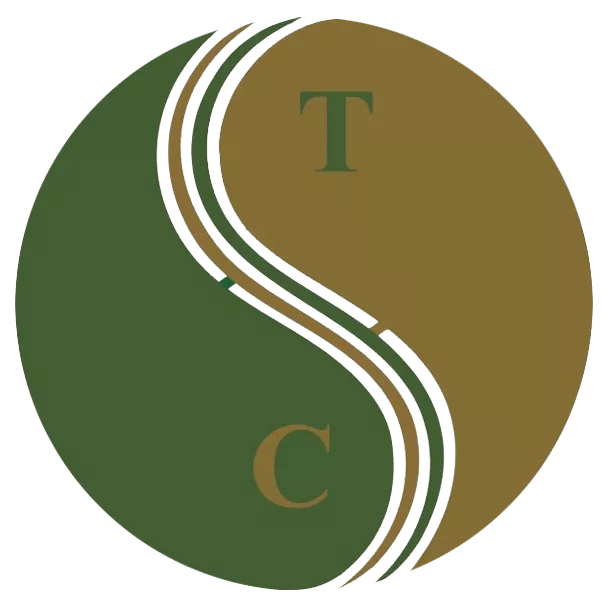 Art of Wellness Acupuncture & Traditional Chinese Medicine (TCM)11704 Wilshire Blvd, Suite 295, Los Angeles, CA, 90025
Art of Wellness Acupuncture & Traditional Chinese Medicine (TCM)11704 Wilshire Blvd, Suite 295, Los Angeles, CA, 90025
myartofwellness@gmail.com310-451-5522 Office Hours
MonClosedTue7:30 am --4 pmWed7:30 am --4 pmThu7:30 am -- 4 pmFri7:30 am -- 4 pmSat7:30 am -- 4 pmSunClosedOur office opens from Tuesdays to Saturdays 7:30 am to 4 pm, will be closed on Memorial day, Independent day, Labor day, Thanksgiving day, Christmas and New year.
-
Recent Posts
- How to Treat Rosacea With Acupuncture and TCM
- How to Treat Perioral Dermatitis With Acupuncture and TCM
- Lymphatic Drainage With Acupuncture and TCM
- How to Treat Turf Toe With Acupuncture
- How to Treat Nerve Pain With Acupuncture and TCM
- How to Treat Watery Eyes With Acupuncture and TCM
- How to Treat Ovarian Cysts With Acupuncture and TCM
- How to Treat Dystonia With Acupuncture and TCM
- Can Acupuncture Help Bad Breath?
- How to Treat Atopy with Acupuncture and TCM
- Plantar Fasciosis Treatment With Acupuncture and TCM
- How to Protect Yourself When Air Quality Is Poor
- How to Treat Spinal Headache With Acupuncture and TCM
- How to Treat Sarcoidosis With Acupuncture and TCM
- How to Treat Flu With Acupuncture and TCM
- Chinese New Year 2025 Year of the Snake
- Sign up to receive news and updates and get my free report:“The Top 10 Reasons to Try Acupuncture”

Massage
Lymphatic Drainage With Acupuncture and TCM
By Xiaomei Cai, L.Ac., Ph.D. and Qineng Tan, L.Ac., Ph.D.
Persistent swelling in your arms, legs, or other areas of your body? This could be a sign of lymphedema, a condition caused by the buildup of lymphatic fluid. Acupuncture and Traditional Chinese Medicine (TCM) offer a gentle and effective way to promote lymphatic drainage and support the body’s natural detoxification process.
What Is Lymphedema?
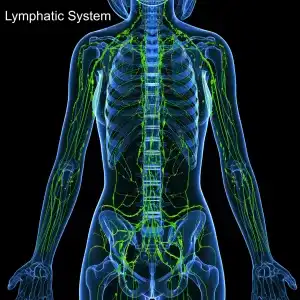
The lymphatic system is a complex network of nodes, tubes and ducts that move lymph fluid through the body, carrying immune cells (like T cells, B cells, and NK cells) that fight against bacteria, viruses, cancer cells, and damaged cells.
Lymphedema is a chronic condition that occurs when the lymphatic system is unable to properly drain lymph fluid, leading to fluid retention and tissue swelling. When the system is blocked or damaged, lymph can accumulate in the tissues, causing swelling and discomfort.
Top 10 Symptoms of Lymphedema
Signs of lymphedema, or lymphatic edema, can develop slowly over time or come on quite suddenly. At first, you may notice that a part of your body is a little swollen, or that your arm or leg just seems a little bit more swollen and stiff than the other one. Your clothes might seem a little bit tighter.
You might notice that you can’t see veins in your limbs, when you used to be able to. Your joints just may seem stiff. It can be easy to attribute mild symptoms of lymphedema to hot weather, general inflammation, or simply aging.
As lymphedema progresses to more severe stages, you may begin to notice that the affected areas are always stiff and swollen, firm to the touch, and that the skin in those areas is becoming noticeably thicker.
Common symptoms of lymphedema include:
- Swelling in the arms, legs, fingers, toes, face, or trunk
- A feeling of heaviness or tightness in the affected area, restricted range of motion
- Aching or discomfort in the swollen limb
- Recurring infections in the affected area
- Hardening or thickening of the skin (fibrosis), redness, itchy skin, rosacea
Symptoms of lymphedema may worsen over time if they are not addressed. Acupuncture and TCM offer a holistic way to treat lymphedema and manage the underlying conditions that cause swelling.
Common Causes of Lymphedema
There can be many different factors that lead to a buildup of lymphatic fluid. A few of the most common causes of lymphatic edema include:
- Surgical removal of lymph nodes (commonly due to cancer treatment)
- Radiation therapy that damages lymph vessels or nodes
- Infections that cause inflammation and blockage of lymphatic vessels
- Cancer that spreads to or blocks lymph nodes
- Injury or trauma to the lymphatic system
- Congenital malformations or underdeveloped lymphatic vessels (primary lymphedema)
- Obesity and sedentary lifestyle that impair lymph flow
Treatment for Lymphedema
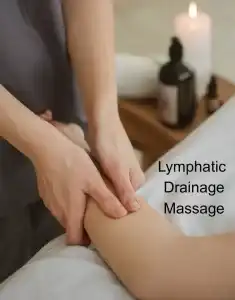
Conventional treatment for lymphedema typically focuses on symptom management and improving quality of life. This may include a recommendation to wear compression garments like sleeves or stockings to encourage lymph flow. Manual lymphatic drainage (MLD): A specialized massage technique performed by trained therapists to move lymph fluid manually.
Gentle, regular physical activity may be recommended to help stimulate lymphatic circulation.
Machines known as Pneumatic compression devices, such as inflatable sleeves worn on the limbs, can mimic manual drainage.
In some cases, procedures to remove excess tissue or improve drainage pathways.
While these methods can help manage the symptoms, they often need to be maintained consistently and may not address the underlying systemic imbalances.
TCM View of Lymphedema
In Traditional Chinese Medicine, lymphedema is viewed as a disruption of the body’s natural flow of Qi (vital energy) and fluids. According to TCM theory, the spleen plays a central role in fluid metabolism. When the spleen Qi is weak or deficient, it cannot properly transform and transport fluids, leading to dampness and phlegm accumulation. This internal dampness can settle in the limbs and cause swelling.
Lymphedema may also be related to stagnation of Qi and blood, particularly in the channels (meridians) that traverse the affected area. External factors like trauma, surgery, or radiation can block the flow of Qi and blood, creating what TCM refers to as “blood stasis.”
Key TCM patterns that may contribute to lymphedema include:
- Spleen Qi deficiency
- Damp accumulation
- Qi stagnation
- Blood stasis
Can Acupuncture Help With Lymphatic Drainage?
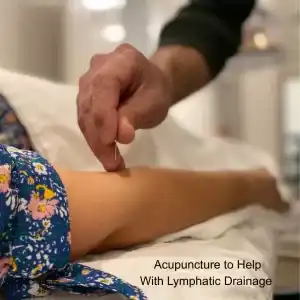
Acupuncture helps to regulate the flow of Qi and blood through the meridians. When specific points are stimulated, they can promote circulation and encourage the movement of stagnant fluids.
Herbal medicine and acupuncture treatments can strengthen the spleen’s function of fluid transformation and transport. Strengthening the kidneys also helps resolve chronic dampness and supports the body’s ability to detoxify.
Research has shown that acupuncture has anti-inflammatory and analgesic effects. For patients experiencing pain, heaviness, and aching due to lymphedema, acupuncture can provide relief.
A healthy lymphatic system is essential for immune function. Acupuncture has been found to modulate immune activity and may help reduce the frequency of infections associated with lymphedema.
Gentle massage techniques like Tui Na and Gua Sha can be applied along the meridians to manually stimulate lymphatic drainage. Unlike deep tissue massage, these methods work with the body’s energy system to promote gentle, effective movement of fluids without overwhelming the tissues.
One study of women who had breast cancer related lymphedema found that twice weekly acupuncture sessions over the course of four weeks helped reduce swelling in their arms.
A review of studies on acupuncture treatment for cancer patients showed that acupuncture not only helped with lymphatic swelling, but also helped to relieve anxiety and depression, nausea and vomiting, and chemotherapy induced neuropathy.
Acupuncture Near Me for Lymphatic Drainage in West Los Angeles
Lymphedema can be a chronic and frustrating condition, but there are holistic options that go beyond symptom management. Acupuncture and TCM offer time-tested methods to support lymphatic drainage, strengthen the body’s natural detox systems, and relieve discomfort. If you’re living with lymphedema or chronic swelling, reach out to us at Art of Wellness Acupuncture in West Los Angeles. We’d be happy to create a personalized treatment plan to help you feel lighter, more comfortable, and more energized again.
*This article is for education from the perspective of Traditional Chinese Medicine only. The education provided by this article is not approved by FDA to diagnose, prevent, treat and cure human diseases. It should not stop you from consulting with your physician for your medical conditions. Traditional Chinese Medicine is based on Qi, which is an invisible force that usually cannot be observed by modern science. Because science focuses on testing ideas about the natural world with evidence obtained through observation, these aspects of acupuncture can’t be studied by science. Therefore acupuncture and Chinese herbs are often not supported by double-blind, randomized trials, and they are considered alternative medicine therapies in the United States.
How to Treat Dystonia With Acupuncture and TCM
By Qineng Tan, L.Ac., Ph.D and Xiaomei Cai, L.Ac., Ph.D.
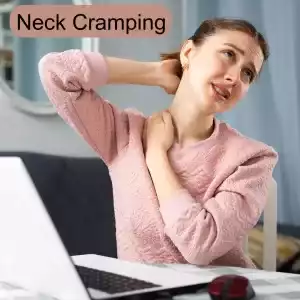
Writer’s cramp? Foot cramps and spasms in your calf muscles? Cramps that cause your toes to curl up or big toe to stick up? These are signs of dystonia, a disorder that causes muscles to contract, causing painful spasms and uncontrollable twisting of body parts. Acupuncture can help relieve symptoms of dystonia and reduce cramping.
Dystonia is a movement disorder that can affect one part of the body, such as the hand, or several parts of the body, causing painful cramping and involuntary muscle contractions.
Dystonia most often affects the hands, feet, and neck (cervical dystonia or neck dystonia). When the cramping only happens in one area, this is known as focal dystonia, i.e. focal dystonia hand, or focal hand dystonia.
Acupuncture can help relieve symptoms of dystonia without injections or surgery.
Top 5 Kinds of Dystonia
Dystonia muscle cramping and spasming can happen in various parts of the body, including:
- Neck (Cervical Dystonia) – spasm pulls the head to one side forward or backward.
- Hand – usually triggered by a certain activity, like writing, playing an instrument, or playing golf.
- Jaw – (Oromandibular Dystonia) – causes trouble with chewing, swallowing or drooling, can happen concurrently with cervical dystonia.
- Eyelids (Blepharospasm) – spasms cause the eyelids to close, can also feel like dry eyes, sensitivity to light. Can be triggered by light, screens, and stress.
- Vocal Cords (Laryngeal Dystonia) – strained voice, only able to speak in a whisper.
For some people, dystonia does not cause pain, while for others, it can become increasingly painful. In some cases, dystonia may plateau; in others, it gets progressively more severe.
Over time, some types of dystonia can lead to the deterioration of joints and arthritis.
What Causes Dystonia?
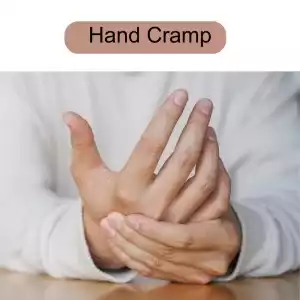
Medical science is not entirely clear on the specific causes of dystonia. There may be some genetic predisposition for dystonia. Some types of dystonia show up without any seeming correlation to other issues (primary dystonia). Other kinds of dystonia manifest as symptoms of another disorder affecting the nervous system.
Muscle spasms can be a symptom of several different disorders, including:
- Huntington’s disease
- Parkinson’s disease
- Stroke
- Brain injury or brain tumor
- Encephalitis
- Tuberculosis
- Carbon monoxide poisoning or heavy metal poisoning
Some types of dystonia can be brought on by a specific physical activity. Mental, emotional, and physical stress can also trigger an episode of dystonia cramping.
Some studies have suggested that there is a problem with motor programming, or a deficiency in the motor cortical network of the nervous system.
Treatment for Dystonia
The most common form of treatment for focal dystonia, such as the kind that causes “writer’s cramp,” is botulinum neurotoxin (BNT or Botox) injections. This is a localized treatment that helps relieve symptoms by blocking the release of chemicals involved in muscular contractions.
Patients feel their muscles relax within a few days or a week. The results of this treatment typically only last for a few months, and then another injection is needed.
Deep brain stimulation (DBS) is a surgical method used to treat dystonia. This involves the implantation of a stimulator that is somewhat like a pacemaker; it is controlled remotely and stimulates parts of the brain that affect muscular contractions.
Acupuncture can be a good alternative treatment modality for reducing the muscle spasms associated with dystonia.
Can Acupuncture Help Dystonia?
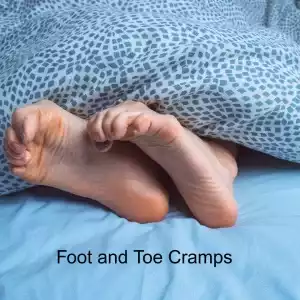
TCM theory views most health issues as being related to internal or external pathogenic forces causing imbalance within the organ systems. Organ systems in TCM are interrelated in ways that may seem counterintuitive from the “Western medicine” point of view. For example, in TCM, the actions of the muscles and tendons are related to the liver system.
Pathogenic forces like wind, damp, and heat can arise or attack the organ systems and cause problems. In the case of dystonia, excess wind in the liver affects the tendons and muscles, causing them to be overactivated.
In some cases, dystonia is triggered by emotional stress. If a patient is experiencing anxiety or depression, then that is also a factor that needs to be addressed.
Thus, the acupuncturist will create a treatment protocol designed to use different TCM modalities to address the root cause of the problem and the symptoms. Acupuncture to treat dystonia will address the liver wind and also be used to help relax the muscles. Treatment can also focus on relieving stress and balancing the person’s emotional state.
Acupuncture treatment is often used to help stimulate muscle tone. In cases of dystonia, we will use acupoints on the meridians related to the affected muscles as a way of both suppressing muscle tone and activating it. Some of the muscles related to the area that is cramping up might be hypertonic (tight and rigid), while others might be hypotonic (not active or offering resistance).
One study that looked at acupuncture treatment for cervical dystonia used electromyogram to measure muscle activity, and it showed that shallow placement of acupuncture needles decreased excess activity in the muscles.
Another study looked at patients who had been receiving Botox treatment for their cervical dystonia. They then received a series of 6 sessions of acupuncture treatment. All of the patients reported improvement and two-thirds of the patients intended to continue acupuncture treatments for management of their condition.
Gua sha and other forms of Chinese massage can also be used to help with dystonia.
Moxibustion or moxa, which is a warming herb that is burned near the affected area, can also be helpful to relieve cramping.
Acupuncture Near Me for Dystonia
Dystonia can be a serious disruption to your daily life and activities, making you feel out of control in your body. In some cases, dystonia causes serious pain. If you have been experiencing severe muscle cramping in specific areas, please do not hesitate to reach out to us at Art of Wellness for help. Drs. Tan and Cai have over 35 years of experience helping to treat conditions of all kinds that affect the nervous system and cause musculoskeletal problems.
*This article is for education from the perspective of Traditional Chinese Medicine only. The education provided by this article is not approved by FDA to diagnose, prevent, treat and cure human diseases. It should not stop you from consulting with your physician for your medical conditions. Traditional Chinese Medicine is based on Qi, which is an invisible force that usually cannot be observed by modern science. Because science focuses on testing ideas about the natural world with evidence obtained through observation, these aspects of acupuncture can’t be studied by science. Therefore acupuncture and Chinese herbs are often not supported by double-blind, randomized trials, and they are considered alternative medicine therapies in the United States.
How to Treat Myofascial Pain Syndrome With Acupuncture and TCM
By Xiaomei Cai, L.Ac., Ph.D. and Qineng Tan, L.Ac., Ph.D.
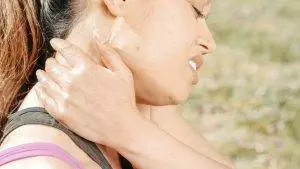
Muscle aches and pains? Knotted muscles? Pain in trigger points? These could be signs of myofascial pain syndrome. Acupuncture and TCM can provide myofascial release and help relieve chronic myofascial pain (MPS pain).
Myofascial pain disorder is a common, yet often overlooked chronic pain condition that affects the muscles and fascia. Fascia is the thin connective tissue that is found all over the body, holding muscles, organs, and blood vessels together. Fascia is also filled with nerves, which makes it highly sensitive.
Healthy fascia is thin, stretchy and pliable. Stress, injuries, weakness and other issues can cause fascia to tighten up, become sticky, dry, or thicker. This can cause painful knots to develop in your muscles.
These areas are sometimes called fascial adhesions, or myofascial trigger points, and they can be very tender to the touch and cause muscle soreness, aches and pains.
Chronic myofascial pain can seem very similar to fibromyalgia, or symptoms of ME/CFS, and is sometimes misdiagnosed as such. However, these conditions are distinct from one another.
Fibromyalgia causes widespread, diffuse pain and tenderness all over the body, while myofascial pain is centered around specific trigger point sites. Fibro, as it is sometimes called, is believed to be caused by a disorder within the central nervous system. Fibromyalgia is usually triggered by stress, trauma, hormonal changes, lack of sleep, or sensitivities to weather changes.
It has been suggested that long-term myofascial pain syndrome may ultimately lead to a person developing fibromyalgia, as the brain and nervous system become so used to experiencing pain that they begin to produce disordered pain signaling.
Acupuncture treatment, cupping, and therapeutic Chinese massage can provide trigger point therapy that is effective for relieving tight muscles and soreness.
Myofascial Pain Syndrome Symptoms
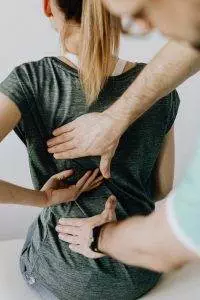
People experience myofascial pain differently from one another; each case is unique. For some people, the pain can come and go suddenly; for others, it’s a constant, dull pain.
Myofascial pain syndrome can feel like:
- Tight muscles, stiffness
- Throbbing pain
- Dull, aching pain
- Sore muscles, tender areas
- Knotted muscles, nodules or bumps in specific areas that are sore
- Muscle weakness
- Limited range of motion
- Trouble sleeping
- Headaches
- Fatigue
Myofascial pain can be localized in one area, or referred pain, which spreads to other nearby areas. Myofascial referred pain patterns can look like pain that originates in the rotator cuff which then spreads to the deltoid, and even down the arm to the hand.
What Causes Myofascial Pain?
Medical science is not entirely clear on the causes of myofascial pain syndrome, but it seems to occur more often in people who have experienced things like:
- Periods of inactivity, such as having one of your limbs in a cast
- Repetitive movements in your work
- Pinched nerves
- Injury to a muscle or muscle group
- Having to work outdoors in the cold
- Diabetic neuropathy
- Thyroid disorders, hypothyroidism
- Deficiencies in Vitamin D or folate, or iron deficiency
- Stress, chronic tension that leads to clenched muscles
- Structural conditions like scoliosis, spondylosis, or osteoarthritis
Estimates suggest that the majority of people who are treated for chronic musculoskeletal pain may have myofascial pain syndrome. Up to 85% of the general population may experience myofascial pain at some point in time.
Treatment for Myofascial Pain Syndrome
One of the primary approaches to managing myofascial pain syndrome is physical therapy. Physical therapists may use manual therapy, stretching exercises, and postural correction to address muscle imbalances, improve flexibility, and release tension in affected muscles. Trigger point therapy, which involves applying pressure to trigger points to release muscle knots and promote relaxation, is a common component of physical therapy for MPS.
Modalities such as heat therapy and cold therapy may also be used in conjunction with physical therapy to provide pain relief and enhance the effectiveness of treatment. Heat therapy helps to increase blood flow and promote muscle relaxation, while cold therapy can reduce inflammation and numb the affected area.
In addition to physical therapy and modalities, medications may be prescribed to manage pain and improve symptoms associated with myofascial pain syndrome. Nonsteroidal anti-inflammatory drugs (NSAIDs) such as ibuprofen or naproxen may be recommended to reduce inflammation and alleviate pain. Muscle relaxants such as cyclobenzaprine or benzodiazepines may also be prescribed to help relax tense muscles and improve sleep quality. In some cases, tricyclic antidepressants or anticonvulsant medications may be used to modulate pain signals and improve overall pain management.
Trigger point injections are another treatment option for myofascial pain syndrome, particularly for individuals who experience severe or persistent symptoms that do not respond adequately to conservative measures. During a trigger point injection procedure, a local anesthetic or corticosteroid is injected directly into the trigger point to help alleviate pain and reduce muscle tension.
Acupuncture needling is also considered an effective and valuable treatment option for myofascial release and relief of musculoskeletal pain.
Can Acupuncture Help Myofascial Pain Syndrome?

Many studies conducted over the past two decades point to acupuncture as an effective mode of treatment for myofascial pain syndrome.
Acupuncture is effective for myofascial pain because it can positively affect the central nervous system, increase blood flow, increase endorphin production, improve fascial adhesions, and promote muscle relaxation. Acupoints used in TCM correspond closely with myofascial trigger points.
One study looked at patients who received two acupuncture treatments per week for four weeks on trigger points in the upper trapezius. Patients reported significant reduction in pain after just two weeks.
Another study followed two groups of patients with myofascial pain centered in the neck area. One group received acupuncture treatment. The other group had acupuncture and also engaged in regular aerobic exercise. Findings showed that both groups experienced significant improvement in pain symptoms.
A review of studies found that acupuncture was effective both for reducing myofascial pain and improving function and mobility.
Acupuncturists may also use electro-acupuncture, cupping, and massage techniques like gua sha and tui na to help move lymph and blood, release muscle trigger points, and improve muscular movement that has been limited by pain.
Acupuncture Near Me for Myofascial Pain Syndrome in Los Angeles
At Art of Wellness Acupuncture in West L.A., we have over 35 years of experience helping people find relief from musculoskeletal pain of all kinds. Dr. Tan and Dr. Cai are able to use electro-acupuncture, cupping, and massage techniques like Tuina for myofascial release. If you are suffering from muscle pain and tenderness, do not hesitate to make an appointment with us.
*This article is for education from the perspective of Traditional Chinese Medicine only. The education provided by this article is not approved by FDA to diagnose, prevent, treat and cure human diseases. It should not stop you from consulting with your physician for your medical conditions. Traditional Chinese Medicine is based on Qi, which is an invisible force that usually cannot be observed by modern science. Because science focuses on testing ideas about the natural world with evidence obtained through observation, these aspects of acupuncture can’t be studied by science. Therefore acupuncture and Chinese herbs are often not supported by double-blind, randomized trials, and they are considered alternative medicine therapies in the United States.
How to Treat Aging Skin With Cosmetic Acupuncture
By Xiaomei Cai, L.Ac., Ph.D. & Qineng Tan, L.Ac., Ph.D.
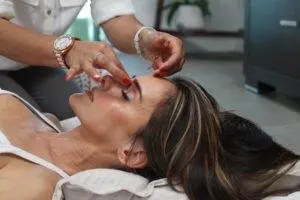
Looking for a treatment that can help smooth fine wrinkles, boost collagen and firm skin? Maybe you’ve heard about cosmetic acupuncture, also known as facial rejuvenation, or an acupuncture face lift, and you’re wondering if it really works. TCM and acupuncture offer a natural, health-centered skin care alternative to surgery and other procedures for people of all ages who want to look younger and more well-rested.
We all want to look in the mirror and see ourselves looking our best. Cosmetic procedures like plastic surgery and minimally-invasive aesthetic treatments have increased by well over 200% in the past twenty years. People of all genders and ages are showing more interest than ever in anti-aging treatments that can tighten, tone, and brighten the skin, banish puffiness and dark circles under the eyes, clear acne blemishes and scars, and reduce the appearance of wrinkles. While advances are continually being made in the field of aesthetic medicine, and the stigma surrounding such treatments has been largely reduced, some of these procedures can be harsh and invasive. Many people may prefer to seek a natural alternative.
The TCM approach to skin care is holistic and health-oriented, focusing on creating healthy, lively skin from the inside out. Finding the root internal causes of dull, sagging skin, lack of muscle tone, dryness and other skin problems, and treating them with targeted acupuncture points, herbs used both topically and internally, and the right nutrition program, can all lead to a more youthful and invigorated appearance. The results, of course, will not change your face so dramatically that you look like a different person. It is important that any time you consider an aesthetic procedure, you manage and maintain realistic expectations. But cosmetic acupuncture treatment can help you to feel better about yourself, inside and out.
What Is an Acupuncture Face Lift?
Cosmetic acupuncture, while seeking to improve the overall appearance of the face and neck, is really based in optimizing the patient’s health throughout the body. Acupuncture needling works on several levels. Usually, we explain how stimulating points with acupuncture affects Qi (life force energy) as it flows through the meridian pathways of the body, producing changes in the function of the organ systems. But it also works on the skin-deep level, creating micro-trauma to the skin and underlying tissues that triggers repair and rebuilding. If you have had acupuncture before, you might have felt your acupuncturist gently turn the needles after inserting them. Research has shown how this age-old technique actually does produce a direct effect on collagen fibers. This is partly why acupuncture treatment helps you heal from musculoskeletal injuries and chronic pain conditions. It also helps your skin heal and regenerate.
Acupuncture is also proven to aid in the release of endorphins, which help you feel happier and more relaxed. We all know that a positive outlook can do wonders for your looks. Acupuncture treatment not only gives you the appearance of being well-rested; it actually helps you sleep better and relieves stress that can cause frowning and worry lines.
Your practitioner will choose specific acupoints to target your individual needs, addressing other skin concerns in addition to the signs of aging, including acne and rosacea.
Often, people notice a difference in their appearance right away, as even one treatment can help the skin take on a new glow, and most people emerge from their acupuncture session feeling that they have had a good rest. Generally, we recommend that, in order to see noticeable results, you start with 1-2 treatments per week for at least a few weeks, then continue with a monthly treatment to maintain the results.
A scientific study used topographic imaging to measure the contours of patient’s faces as they underwent a course of five cosmetic acupuncture treatments. The researchers concluded, based on the images and patients’ self-assessments, that facial cosmetic acupuncture produced significant improvement in skin elasticity.
A systematic review of TCM cosmetic acupuncture study data showed that patients reported positive results, including: fewer wrinkles and better skin condition, with improved moisture content.
Cosmetic Acupuncture Vs. Botox
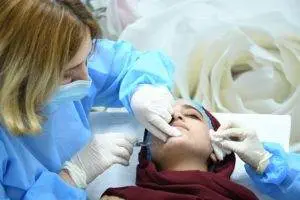
In recent years, Botox injections have become an extremely popular and acceptable way to combat the primary “problem” of aging skin: wrinkles. Facial skin is creased every time we move the facial muscles to express ourselves. Over time, as skin loses its elasticity, these creases become deeper and more defined. Botox (short for botulinum toxin) is a paralytic agent, which means it temporarily “freezes” or paralyses the muscles that lie under the skin of the face, so that they will not move when a person frowns or smiles. This helps prevent the formation of deeper lines between the eyebrows, for example, or along the nasal-labial folds on either side of the mouth.
While Botox injections are widely considered safe these days, there are risks involved with treatment. Minor short term side effects can include redness, swelling, headaches, or nausea. In some instances, the muscle paralysing action can spread to more necessary parts of the facial musculature, causing speech problems, trouble swallowing, or trouble breathing. It can also cause parts of the face to droop due to muscle weakness. While many people have experienced satisfaction with wrinkle reduction due to Botox treatment, we have probably all noticed cases in which a person ends up looking unnaturally startled, lop-sided, or simply incapable of normal expression.
The effects of Botox are temporary, and in order to maintain the smoother skin, people must return for more injections every few months. Facial acupuncture, too, should be performed regularly to maintain results, but TCM offers a more comprehensive approach to smoothing and preventing wrinkles by boosting collagen production and circulation, improving skin elasticity. Massage techniques such as Gua Sha can firm and tone the facial muscles so that the whole face still moves naturally. Botox injections don’t do anything to improve the health of your skin or light up your eyes from within. Facial rejuvenation with TCM is essentially a risk-free procedure that can provide natural-looking results.
The TCM Approach to Skin Care
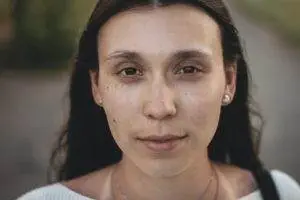
One of the subtler techniques used by TCM practitioners is that of examining a patient’s physiognomy; that is, deducing problems of physical, emotional, and spiritual health by “reading” a person’s face. We can also tell a lot about a person’s internal condition by studying the skin and nails on their hands. This is an art that the acupuncturist can only master with many years of experience.
For example, if there is a tendency to develop dark circles or bags under the eyes and bruise easily, this indicates a stagnation of blood circulation. That deep crease or “frown line” between the eyebrows may indicate a Liver Qi stagnation. The acupuncturist will choose points to stimulate based on each individual’s constitution, working on deeper levels of stagnation in the organ systems, while also targeting specific muscles in the face and neck that need toning.
Naturally, we also use herbs to help nourish the skin. Traditionally, poultices or face masks have been used to directly bring nutrients to the facial skin, while internal herbs taken as teas help to clear heat and dampness from the body. Your TCM provider may also use cupping to draw out toxins and stimulate the lymphatic system; basically, this is like a deep cleaning for your whole body.
Top 5 Tips for Natural Skin Care

We cannot emphasize enough that glowing skin starts within. You may already have a daily skin care routine that involves cleansers and moisturizers, but for the best results, be sure to focus equally on keeping the whole body hydrated, cool, and free of toxins. No matter what age you are right now, you can start making your skin a priority with these simple practices:
- Drink water and green tea – plenty of water keeps the skin cells “plump.” Green tea has been used for centuries to help maintain clear, hydrated skin.
- Get plenty of sleep – There is solid reasoning behind the expression “I need my beauty sleep.” Our cells regenerate and repair themselves while we sleep; this is when the collagen production happens, so give your body plenty of time to do its work.
- Eat the right foods – for healthy skin, make sure to take in enough Omega 3 fatty acids (found in fish oil, good quality eggs, and fresh walnuts), and eat more cooling foods. These include: melon, cucumbers, citrus fruits, cabbage, seaweed, and other greens, mung beans, and soy foods like tofu and tempeh.
- Reduce stress – Stress negatively impacts your skin in a number of ways. Stress can contribute to acne, bags under your eyes, rashes, worry and frown lines, and dryness. Make stress reduction a top priority to improve the overall health of your skin.
- Sun Protection – Getting a little sun (about 30 minutes of exposure) every day is important for the proper functioning of your immune system, but too much sun can be damaging to the skin. Whenever possible, protect your skin with light garments and a hat; this is preferable to the constant use of cosmetic sunscreens, most of which contain potentially toxic chemicals. When you must expose more skin to the sun’s rays, use a sunscreen with natural ingredients.
Cosmetic Acupuncture Near Me
If you’ve been thinking about what sort of medical aesthetic treatments might be right for you, try cosmetic acupuncture for a more youthful look without any side effects or recovery time. There really is no down side to an acupuncture face lift; in fact, your acupuncturist can treat all of your health concerns–back pain, headache, menopause, etc.–,and add the needles for facial rejuvenation all in the same treatment session. Maybe it’s time to give yourself the gift of a little lift with cosmetic acupuncture.
*This article is for education from the perspective of Traditional Chinese Medicine only. The education provided by this article is not approved by FDA to diagnose, prevent, treat and cure human diseases. It should not stop you from consulting with your physician for your medical conditions. Traditional Chinese Medicine is based on Qi, which is an invisible force that usually cannot be observed by modern science. Because science focuses on testing ideas about the natural world with evidence obtained through observation, these aspects of acupuncture can’t be studied by science. Therefore acupuncture and Chinese herbs are often not supported by double-blind, randomized trials, and they are considered alternative medicine therapies in the United States.
How to Treat a Herniated Disc With Acupuncture & TCM
By Qineng Tan, L.Ac., Ph.D. & Xiaomei Cai, L.Ac., Ph.D.
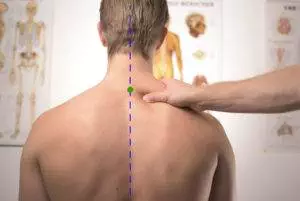
Why do I have a sharp shooting pain down one leg? What should I do if my neck is stiff and hurts to turn? What can I do to help a spasm in lower back? Any of these kinds of pain may be caused by a herniated disc, which presses on the spinal nerves. Acupuncture can be an effective treatment for relieving the symptoms of a slipped disc, while also speeding the healing process–all without negative side effects.
A herniated disc, often referred to as a “slipped disc,” or a bulging disc, occurs when damage to one of the shock-absorbing discs of cartilage that sit between the vertebrae creates pressure on the nerves and muscles of the spine. Also called a prolapsed disc, this condition creates inflammation and swelling in a localized area of the spine and can cause severe pain in the neck, lower back pain, sciatica pain, and tingling that radiates down the leg.
The vertebral column, or backbone, is made up of vertebrae (individual bones) and intervertebral discs. These discs provide cushioning in between the bones and act as ligaments that hold the bones together. The discs create a shock absorption system that protects the spinal column, and are made up of tough, fibrous outer layers of cartilage, with a gel-like substance on the inside. If there is damage to the tissues of the outer layer, the soft, gel interior can be pushed outwards and breach the outer wall. This can create pressure against the nerves of the spinal column, resulting in symptoms of nerve entrapment: pain, numbness, and/or loss of ability.
A herniated disc, also referred to as a “ruptured disc,” most often occurs in the lumbar spine. A lumbar herniated disc may cause severe lower back pain if it is pressing on a nerve. Pressure on the sciatic nerve area can also cause shooting pain, burning pain, numbness, and/or tingling in one or both legs–a condition commonly referred to as sciatica, also known as lumbar radiculopathy. The sciatic nerve is actually a large bundle of smaller nerves that connects the base of the spine to the top of the leg, travelling through the buttock area. There is a sciatic nerve bundle on each side. About 90% of cases of sciatica are related to herniated discs.
Cervical disc herniation refers to a prolapsed disc between one of the seven vertebrae of the cervical spine, or neck area. Compression of the nerves due to a herniated disc in the C2 area can cause headache, or pain in the eye or ear. Herniation of a disc further down the cervical spine happens most commonly in the C5, C6, or C7 area, which can lead to neck pain and/or shoulder pain.
Most of the time, sciatic pain or neck pain due to nerve compression in the spine goes away gradually on its own, but it can cause a lot of suffering over the course of several weeks or months before resolving itself. Medical treatment for herniated disc pain typically involves the recommendation of rest and immobilisation and the use of anti-inflammatory medications, muscle relaxers, and pain relievers. However, lack of movement does not really help improve the root cause of the pain, and the use of pain medications or steroids is often accompanied by unwanted side effects. Acupuncture treatment can significantly reduce acute pain related to sciatica, neck pain, shoulder pain, and low back pain due to slipped discs, often providing immediate, short-term relief of severe pain, while helping, long-term, to reduce inflammation and help heal nerve damage.
Signs of Herniated Disc
When a disc herniates, pain can be sharp and intense. Depending on which disc is affected, there may be neck pain, low back pain, or sciatic pain in the leg, foot, or buttock area. Pain or numbness are caused by the inflammation of the nerve area that is being compressed by the extrusion of the center of the disc.
- A cervical herniated disc (in the neck) may cause burning pain in the side of the neck or sharp pain in the back of the neck. Or there may be a more subtle sensation where the neck is tender to the touch. The pain is usually worse when performing vigorous activities or when twisting or turning the head at a certain angle. The overall movement of the neck and head may feel limited and stiff.
- Pain may radiate down the arm and cause an “electric shock-like” sensation in the hand and fingers.
- Weakness in the muscular movement of the shoulder, arm, hand, thumb and fingers may result from the pinching of the nerves of the cervical spine.
- A lumbar herniated disc (in the lower back) is more likely to cause pain down the leg than in the back. Usually the pain is just on one side of the body. This radiating pain caused by compression of the sciatic nerve can be sharp, burning, and very intense.
- Herniation of a lumbar disc can also cause pain in the low back or buttock. This pain may be of the “throbbing” type, or feel like a spasm. It may be helped by applying cold or heat to the area. The pain typically is worse after sitting or hunching over for a while, or when bending over from the waist.
- The sensation in the buttock, hip, leg and foot may be more like tingling or numbness than searing pain.
- “Foot drop” is when the nerve compression makes it difficult to fully pick up the foot when walking, so that the toes drag on the floor.
The kind of pain caused by a herniated disc can come on quite suddenly and strongly. Fortunately, the pain caused by most herniations of spinal discs resolves in a matter of time without surgery.
What Causes Herniated Disc?
Slipped discs, or bulging disks, happen most often to people between the ages of 30 and 50. The ruptured disk may happen due to one sudden movement, like lifting something heavy, twisting an awkward way, or even a strong sneeze. But prior to such an event, there was probably some weakness already developing in the outer walls of the disc.
Degeneration of the discs can occur over time due to aging. A chronic herniation can develop slowly over years and cause mild symptoms. An acute herniation might happen as the result of some trauma, like an accident, which could create more serious damage to the outer layers of the disc (the annulus fibrosus), allowing the jelly-like material inside (the nucleus pulposus) to extrude, or squeeze out of containment.
Surgery for herniated disc is only recommended in rare cases (10-20%), sometimes if the prolapsed disc is affecting the nerves in such a way that bladder or bowel function is negatively impacted. Surgery may also be considered if pain is severe and continues for a long time without getting better. Herniated disc surgery attempts to relieve the nerve compression by removing some of the disc tissue. In cases where there is more extensive degeneration of the spine, a spinal fusion procedure may involve “fusing” the vertebrae together with screws while removing the original disc tissue and replacing it with an implant. These types of surgeries for herniated disc may help alleviate pain, but there can still be a long recovery period, and the pain is not guaranteed to go away.
Can Acupuncture Help a Herniated Disc?

Traditional Chinese Medicine (TCM) has been developed over the course of thousands of years to deal with all types of pain conditions. In the TCM view, herniated disc pain is caused by:
- Injury to the spine
- Invasion of cold, wind, or damp
- Liver and/or kidney deficiency
In addition to acupuncture treatment, which involves the insertion of very fine needles into specific points along the meridians of the body, we also use treatments such as moxibustion and infrared heat lamps to bring warm energy to parts of the body. TCM treatment for herniated disc will often focus on strengthening the Qi (life force energy) and blood flow to the kidneys, and clearing dampness and bringing warmth to the whole lower back area.
One clinical trial conducted in a hospital demonstrated that acupuncture treatment combined with the application of moxa warm needle therapy with infrared heat and gentle exercise resulted in reporting of 95% improvement in pain related to lumbar herniated disc.
A recent systematic review of acupuncture treatment for disc herniation concluded that acupuncture provided better results than pain medications or lumbar traction.
A study that focused on long-term outcomes for patients with lumbar disc herniation showed that ten years after receiving electric acupuncture treatment for their pain they reported positive long-term results, acupuncture having helped to resolve their sciatica symptoms.
Top 5 Tips for How to Heal a Herniated Disc Naturally
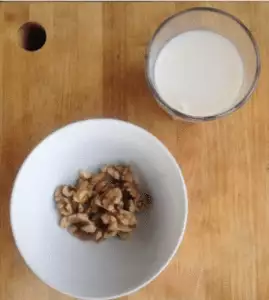
Most pain due to herniated disc will resolve itself in about six weeks without medical treatment. In the meantime, there are some things you can do to help reduce pain and restore freedom of movement.
- Seek out treatment from a qualified acupuncturist. A combination of acupuncture, herbal supplementation, tuina massage, moxibustion, and infrared heat therapy will go a long way towards relieving pain and encouraging healing.
- Heat and Cold Therapy. Try using a heating pad or hot water bottle to apply gentle heat to the lower back or neck. Alternate with icing the affected area. This helps bring more blood flow to the area, reduces inflammation, and soothes stiffness.
- Stay active. It can be tempting to stay in bed when lower back pain and sciatica are causing intense pain or tingling sensations. But immobilisation does not really do anything to help heal nerve pain, and it is actually more beneficial to keep the muscles of the back body strong. Engaging regularly in low-impact activities like walking, biking, or swimming will help keep endorphins flowing and your mood positive better than bed rest will.
- Check your sleeping position. Staying in bed can also hurt when you have a slipped disc. Use a pillow to bolster your knees to help relieve tension in the lower back and keep the spine in proper alignment. Use a firm orthopedic pillow to keep the neck aligned.
- Nutrition for nerve health. Certain nutrients can be especially beneficial for building and maintaining nerve tissues. Emphasize B-6 and B-12 vitamins, Vitamin E and Omega-3 and Omega-6 fatty acids in your diet and with high quality supplements. Nuts, fish, and good plant-based oils should be consumed regularly.
Regular exercise, plenty of sleep, and good nutrition, as always, will go a long way towards helping ensure that a pain condition resolves itself fully and does not return.
Acupuncture Near Me for Herniated Disc
At Art of Wellness, Dr. Tan and Dr. Cai have over 30 years of experience helping patients with acute and chronic pain due to neurological conditions. Pain due to a herniated disc can be effectively reduced by regular acupuncture treatment, while Chinese herbs and therapeutic massage can help bring healing to the nerves and spine, and help prevent future problems with herniated disc and sciatica.
*This article is for education from the perspective of Traditional Chinese Medicine only. The education provided by this article is not approved by FDA to diagnose, prevent, treat and cure human diseases. It should not stop you from consulting with your physician for your medical conditions. Traditional Chinese Medicine is based on Qi, which is an invisible force that usually cannot be observed by modern science. Because science focuses on testing ideas about the natural world with evidence obtained through observation, these aspects of acupuncture can’t be studied by science. Therefore acupuncture and Chinese herbs are often not supported by double-blind, randomized trials, and they are considered alternative medicine therapies in the United States.